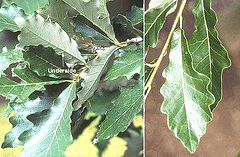White Oak Trees
White Oak is one of the pre-eminent hardwoods of Eastern North America
Quercus alba White Oak
Zones: 3b-8
Sun to part shade
Height: 80-100’
Spread: 50-90’
Shape: Crown is pyramid to rounded
Growth Rate: Slow to moderate
Soil Preference: Prefers acid, moist and well drained soil. Will grow well in a wide range except sand and is tolerant of salt, both in the soil and the air.
Moisture: Will grow in all but the driest soils with a moderate drought tolerance.
Foliage: Moderately dense foliage with green, deeply cut leaves.
Blooms: Brown and inconspicuous
Fruit: Acorns can be produced prolifically but a good crop is generally produced every 4 to 10 years. Production can begin as early as 20 years, but generally at about 50 years.
White oak is an outstanding tree that is widely used across eastern North America, the best conditions being in the central Mississippi River Valleys. It will tolerate climates from central Minnesota to Texas, although it generally will be smaller in drier regions. White Oak roots deeply with a well developed tap root when young, so do not attempt to transplant as the tap root develops. As the tree matures the lateral roots develop and the tap root may disappear. The branches may droop as the tree grows and may require pruning for clearance. Small branches, up to 1 1/2”, may be pruned in the growing season without concern for rot introduction. White Oak is commonly attacked by a variety of leaf eaters, but will not be killed unless a fungus also attacks. Other insect attacks are not significant. Golden Oak scale can cause significant damage, but in general the White Oak is very durable. White Oak is less susceptible to oak wilt than Red Oaks. White Oak trunks flare out at the base and can grow to 6 feet in diameter. Planted to close to a sidewalk or curb can cause the structure to be lifted. Surface roots are not a problem. Autumn foliage turns beautifully red. The White Oaks may live as long as 600 years.
Quercus bicolor Swamp White Oak
Zones: 4-8
Sun to part sun
Height: 50-60’, can reach up to 80’
Spread: 40-50’
Shape: Pyramid when young, then develops an open, rounded to irregular crown
Growth Rate: Moderate to fast
Soil Preference: Performs well in heavy wet soil but will grow in clay, silt or sand, preferring slightly alkaline to acidic. Poor tolerance to salt.
Moisture: Moist to wet, but is also moderately drought tolerant.
Foliage: Leaves have a shiny dark green surface with white underside and are not as deeply cut as other white oaks.
Blooms: Catkins appear with the leaves in spring. Male flowers are yellow-green long catkins, female are very small green to reddish. Male and female flowers are both present, and both are fairly inconspicuous.
Fruit: One inch single or double acorns on a long stalk.
The Swamp White Oak is one of the best medium to large shade trees native to the north central and northeast regions of North America. It is resistant to oak wilt and may be afflicted by common white oak pests, but long term health is rarely affected. The leaves are green on top with a white underside, which is where the name bicolor comes from. Autumn color is brown, yellow-brown to reddish, not typically as well colored as other white oaks. The bark of the Swamp White Oak is dark brown to grayed and is deeply ridged and furrowed. The Swamp White Oak transplants and establishes well, making it a popular choice as a landscaping tree. It is best planted in spring, but container grown can be planted anytime. Roots are relatively shallow but do not usually cause a problem with surface roots. Branches generally grow low to the ground, prune them to allow clearance if needed. It grows rapidly and may live more than 300 years.




